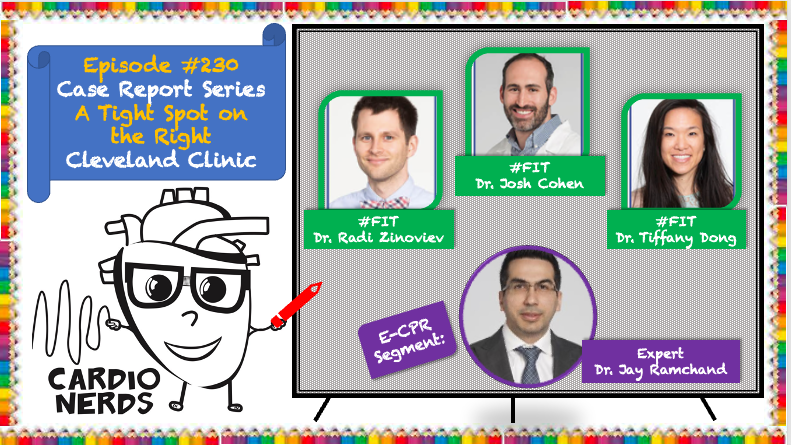Cardionerds: A Cardiology Podcast

230. Case Report: A Tight Spot On The Right – Cleveland Clinic
CardioNerds (Amit Goyal and Dan Ambinder) join Dr. Radi Zinoviev, Dr. Josh Cohen, and Dr. Tiffany Dong (CardioNerds Ambassador) from the Cleveland Clinic for a day on Edgewater beach. They discuss the following case of the evaluation and management of prosthetic tricuspid valve stenosis in a patient with a history of Ebstein Anomaly. The expert commentary and review (ECPR) is provided by Dr. Jay Ramchand, staff cardiologist with expertise in multimodality cardiovascular imaging at the Cleveland Clinic.
This episode is made possible with support from the 3rd Annual Going Back to the Heart of Cardiology (A MedscapeLIVE Conference). Join Dr. Robert Harrington and Dr. Fatima Rodriguez December 3-5, 2022 at the Hilton La Jolla Torrey Pines in San Diego, CA for this innovative event. Network with your colleagues, attend engaging presentations by renowned cardiologists, participate in conference activities, and earn up to 10.25 CME/CE credits. You don’t want to miss the keynote presentation by health and fitness expert Bob Harper (NBC’s The Biggest Loser). Earn up to 3.0 additional CME/CE credits by adding this year’s NEW Virtual Interventional Session: Cath Lab Challenge to your conference registration. Register today with code CARDIONERDS for 30% OFF your registration. Click here for more information.

Jump to: Case media – Case teaching – References

CardioNerds Case Reports Page
CardioNerds Episode Page
CardioNerds Academy
Cardionerds Healy Honor Roll
CardioNerds Journal Club
Subscribe to The Heartbeat Newsletter!
Check out CardioNerds SWAG!
Become a CardioNerds Patron!
Case Media
 CXR
CXR ECG
ECG TTE
TTE RHC
RHC
 Final TTE
Final TTETTE 1
TTE 2
TTE 3
Follow up TTE 1
Follow up TTE 2
Episode Schematics & Teaching
Pearls – Tricuspid Valve Stenosis
- Tricuspid stenosis is uncommon (<1% of the US population) and thus we have a lack of evidence as well as guideline recommendations.
- While there are no official diagnostic criteria for severe tricuspid stenosis, some echocardiographic features include flow acceleration across the valve, a mean pressure gradient of ≥ 5mmHg and an inflow VTI of > 60cm.
- Structural findings that support the presence of severe tricuspid stenosis include a moderately dilated RA and a dilated IVC, though these are not specific.
- Right heart catheterization hemodynamics that support tricuspid stenosis include a high right atrial pressure and gradual “y” descent.
- Bioprosthetic tricuspid valves are generally favored over mechanical valves due to risk of thrombosis and longevity of these valves in the tricuspid position.
- What are causes of tricuspid stenosis?
Causes of tricuspid stenosis can be divided into congenital and acquired causes. Congenital causes include tricuspid atresia or stenosis. Acquired causes include rheumatic heart disease, carcinoid syndrome, endocarditis, prior radiation, or fibrosis from endomyocardial procedures or placement of electrical leads. Rheumatic heart disease is the most common cause of tricuspid stenosis and is usually associated with mitral valvulopathy.
- What are the symptoms and physical exam findings of tricuspid stenosis?
Findings revolve around right sided congestion or heart failure symptoms such as peripheral edema, abdominal distension with ascites, hepatomegaly, and jugular venous distension. When examining the jugular vein, you may see prominent a-waves and an almost absent or slow y descent reflective of delayed emptying of the right atrium (in the absence of tricuspid regurgitation). The murmur of tricuspid stenosis includes an opening snap and low diastolic murmur at the left lower sternal border with inspiratory accentuation. Patients may also report fatigue due to decreased cardiac output from obstruction.
- On echocardiography, what are the features supportive of severe tricuspid stenosis?
Qualitatively, the leaflets may be thickened with reduced mobility and there may be diastolic dooming of the valve. Doppler may show high gradients of ≥ 5 mmHg, which may be elevated if there is coexisting tricuspid regurgitation and lower with decreased cardiac output. Associated structural changes include dilated right atrium and inferior vena cava.
- What is expected on right heart catheterization for tricuspid stenosis?
Assuming the patient remains in sinus rhythm, patients with tricuspid stenosis would display high right atrial pressures and a gradual “y” descent. A diastolic gradient may be measured with dual catheters in the right atrium and the right ventricle.
- What are the treatment options for tricuspid stenosis?
Medical management of tricuspid stenosis includes diuretics and addressing the underlying cause. Intervention is indicated for symptomatic severe tricuspid stenosis although the current 2020 ACC/AHA Valve Guidelines do not address tricuspid stenosis. The 2014 ACC/AHA guidelines give a class I indication for tricuspid stenosis surgery during left sided surgery while there is a class I indication for isolated tricuspid stenosis if symptomatic. Percutaneous options include balloon valvotomy while those who are surgical candidates are eligible for valve repair or replacement. Surgical options include repair or replacement with bioprosthetic favored over mechanical given the latter’s susceptibility to thrombosis.
References – Tricuspid Valve Stenosis
- Nishimura, R. A., et al. (2014). “2014 AHA/ACC Guideline for the Management of Patients With Valvular Heart Disease: executive summary: a report of the American College of Cardiology/American Heart Association Task Force on Practice Guidelines.” Circulation 129(23): 2440-2492.
- Otto, C. M., et al. (2021). “2020 ACC/AHA Guideline for the Management of Patients With Valvular Heart Disease: Executive Summary: A Report of the American College of Cardiology/American Heart Association Joint Committee on Clinical Practice Guidelines.” Circulation 143(5): e35-e71.






 Visit Podcast Website
Visit Podcast Website RSS Podcast Feed
RSS Podcast Feed Subscribe
Subscribe
 Add to MyCast
Add to MyCast